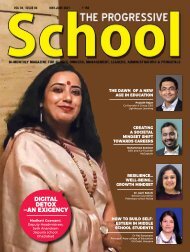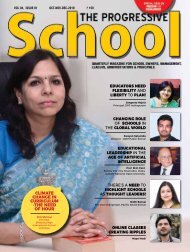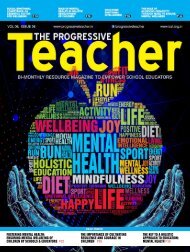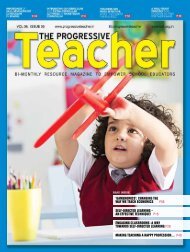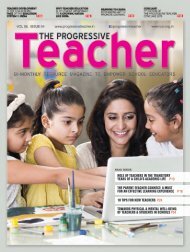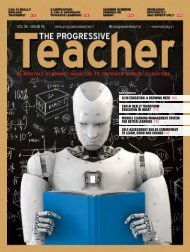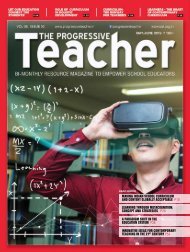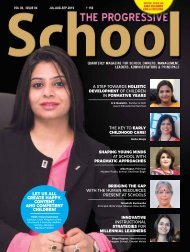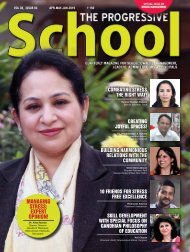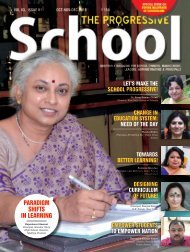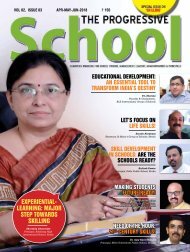The Progressive Teacher Vol 04 Issue 03
This issue of The Progressive Teacher focuses on "New Trends in Education ". In this edition, articles explore contemporary trends to enhance interactive learning amongst students.
This issue of The Progressive Teacher focuses on "New Trends in Education ". In this edition, articles explore contemporary trends to enhance interactive learning amongst students.
You also want an ePaper? Increase the reach of your titles
YUMPU automatically turns print PDFs into web optimized ePapers that Google loves.
atmosphere that allows for<br />
free thinking.<br />
• Communication and<br />
Expression: Creates a<br />
scaffolding to develop<br />
emotional maturity by<br />
guiding the child to express,<br />
understand, accept and<br />
control feelings and emotions.<br />
• Social skills: Helps the child<br />
imbibe values, social attitudes<br />
and manners important in his/<br />
her socio- cultural context.<br />
<strong>The</strong>y learn to share ideas,<br />
collaborate and wait for their<br />
turn.<br />
• Creativity: Pushes<br />
the children to become<br />
independent thinkers and<br />
develop creative thinking<br />
by providing sufficient<br />
opportunities for selfexploration,<br />
improvisation and<br />
experimentation. Children find<br />
new ways to move by taking<br />
risks and many possibilities.<br />
This skill combined with<br />
critical thinking capacitates<br />
problem solving.<br />
<strong>The</strong>se essential life skills are<br />
required today more than<br />
academic excellence in order<br />
for us to stay grounded, deal<br />
with and excel in today’s society.<br />
<strong>The</strong>se skills cannot be taught<br />
but have to be experienced and<br />
nurtured from a very young age.<br />
Creative movement then becomes<br />
a bridge to facilitate children to<br />
become comfortable with their<br />
bodies and in turn with who they<br />
are. Movement is an integral<br />
part of learning. Research shows<br />
that learning and cognitive<br />
development go hand in hand.<br />
So if we look at movement and<br />
add the creative aspect to it then<br />
we are enhancing meta-cognitive<br />
aspects of thinking.<br />
‘Think about Thinking’ is<br />
something I learnt from<br />
Mediated Learning Experience.<br />
This method mediates in a<br />
way where children begin to<br />
constantly think about thinking.<br />
This method of facilitation is<br />
critical for a child to understand<br />
Preeti Sunderajan is an accomplished dancer, choreographer, teacher,<br />
educator and entrepreneur. Preeti’s performing career spans over<br />
30 years. She has performed at several prestigious festivals across<br />
India, USA, UK and Australia. In addition to being a classically trained<br />
Bharatanatyam dancer, Preeti is trained in Yoga, Contemporary dance,<br />
Chau, Folk <strong>The</strong>atre and Kalaripayattu.<br />
In 2006 she became an entrepreneur and started Shiri Dance Company.<br />
<strong>The</strong> aim was to build a dance company of professional dancers and<br />
artists to create neo- classical pieces of work and to do research in the area of movement<br />
and learning. She understood the deeper meaning of performing arts and its impact on<br />
child development and saw the need for an effective Creative Movement in education. She<br />
successfully launched a structured curriculum called Body Talk. Preeti joined FitKids in<br />
2014 as CEO of GAIT (Grooming Artistic Innovation and Talent). She has been successful in<br />
creating, developing and establishing GAIT as the largest and first ever Creative Movement<br />
in Education programme across schools in India.<br />
Jul/Aug 2017<br />
and apply. When we do this<br />
while using movement to create<br />
we are empowering a child in<br />
many different ways. <strong>The</strong> child<br />
has to think in order to create,<br />
find meaning for his ideas and<br />
has to be able to transcend<br />
through his actions. This also lays<br />
the foundation for body mind<br />
connect and critical thinking.<br />
In order for this change<br />
to happen in a child the<br />
atmosphere we create becomes<br />
very important in order to<br />
give an impetus to learning<br />
through creative movement. <strong>The</strong><br />
atmosphere should be free of<br />
judgment, where no answer is<br />
right or wrong, it should ensure<br />
that the process is given far<br />
more importance than the end<br />
result. A curriculum framework<br />
needs to be developed which will<br />
give the child a clear pathway<br />
where success can be seen at<br />
shorter intervals. This will allow<br />
us to have clear objectives and<br />
outcomes.<br />
It is important as parents and<br />
educators that we create the<br />
same atmosphere of learning and<br />
enrichment at all times for the<br />
child. Some of the simple ways<br />
we can create this are:<br />
• Open ended questions- At<br />
the end of an activity it is<br />
important to ask open ended<br />
questions which allow the<br />
child to think. <strong>The</strong>se are<br />
typically ‘Why, What, Where,<br />
When and How’ questions.<br />
As adults we are very<br />
enthusiastic about giving the<br />
right answer. Instead when a<br />
child has done a task take a<br />
step back and enquire about<br />
what he did. A simple activity<br />
could be, you play a track of<br />
music and ask them to move<br />
in a manner they wish with<br />
their eyes closed. <strong>The</strong>n ask<br />
them why they moved the<br />
way they did. What was the<br />
intention of the movement?<br />
What did they feel? How else<br />
would they have liked to do<br />
the activity?<br />
• Praise the process not the<br />
result – Often we love to<br />
praise the child who has given<br />
us the right answer. Instead<br />
step back and look at how<br />
children are arriving at their<br />
answers. This gives room for<br />
thinking and analysing the<br />
process. Give any task with a<br />
few obstacles. Once they have<br />
finished it, talk to them about<br />
how they went about finishing<br />
the task. What strategies did<br />
they use and if they felt it<br />
worked or not.<br />
• Do not get worried about<br />
right or wrong answers<br />
-When children are trying<br />
something they want to<br />
usually please the adult. This<br />
does not allow them to take<br />
risks and fail. Give activities<br />
that allow the child to come<br />
up with multiple ways of<br />
arriving at a solution. A<br />
simple example would be move<br />
from Point A to Point B but<br />
don’t crawl or use your feet<br />
to move. Children are at first<br />
confused but instantly find<br />
several ways to use their bodies<br />
to move. This simple activity<br />
allows the children to take<br />
risks and not be bothered if<br />
they fail.<br />
• Perspectives - When we look<br />
at responses from children<br />
from different perspectives<br />
then we realise it all ‘depends’<br />
on how they perceive it. Give a<br />
child an abstract piece of art<br />
and turn it around after each<br />
response. You can see how each<br />
response is different and how it<br />
all depends on from where the<br />
child is looking<br />
at it.<br />
Creativity comes when there<br />
are limited inputs and you<br />
are required to come up with<br />
unlimited outcomes. This<br />
capacitates thinking as a general<br />
way of living. Expression of<br />
creative ideas is a beautiful<br />
outcome of this process. So, we<br />
can say that using the framework<br />
of performing arts we can make<br />
correlations with essential skills<br />
required for all round child<br />
development in an inclusive way.<br />
Creative movement in education<br />
provides the means to enhance<br />
ones inner potential in a world<br />
where the outcomes are largely<br />
academics driven. It makes<br />
learning a way of life and the<br />
child will be able to think reason<br />
and understand better the world<br />
around him/her.<br />
www.progressiveteacher.in 9




